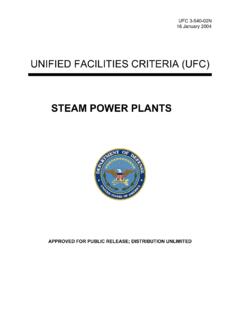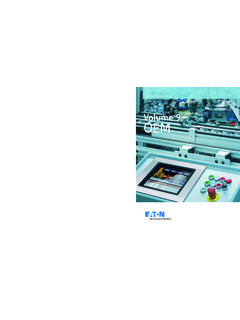Transcription of DOE FUNDAMENTALS HANDBOOK - Steam Tables Online
1 DOE-HDBK-1012/1-92 JUNE 1992 DOE FUNDAMENTALS HANDBOOKTHERMODYNAMICS, HEAT TRANSFER,AND FLUID FLOWV olume 1 of Department of EnergyFSC-6910 Washington, 20585 Distribution Statement A. Approved for public release; distribution is document has been reproduced directly from the best available to DOE and DOE contractors from the Office of Scientific and Technical O. Box 62, Oak Ridge, TN 37831; (615) to the public from the National Technical Information Service, Department ofCommerce, 5285 Port Royal Rd., Springfield, VA No. DE92019789 THERMODYNAMICS, HEAT TRANSFER, AND FLUID FLOWRev. 0 HTABSTRACTThe Thermodynamics, Heat Transfer, and Fluid Flow FUNDAMENTALS HANDBOOK wasdeveloped to assist nuclear facility operating contractors provide operators, maintenancepersonnel, and the technical staff with the necessary FUNDAMENTALS training to ensure a basicunderstanding of the thermal sciences. The HANDBOOK includes information on thermodynamicsand the properties of fluids; the three modes of heat transfer - conduction, convection, andradiation; and fluid flow, and the energy relationships in fluid systems.
2 This information willprovide personnel with a foundation for understanding the basic operation of various types of DOEnuclear facility fluid Words: Training Material, Thermodynamics, Heat Transfer, Fluid Flow, Bernoulli'sEquationTHERMODYNAMICS, HEAT TRANSFER, AND FLUID FLOWRev. 0 HTFOREWORDThe Department of Energy (DOE) FUNDAMENTALS Handbooks consist of ten academicsubjects, which include Mathematics; Classical Physics; Thermodynamics, Heat Transfer, and FluidFlow; Instrumentation and Control; Electrical Science; Material Science; Mechanical Science;Chemistry; Engineering Symbology, Prints, and Drawings; and Nuclear Physics and ReactorTheory. The handbooks are provided as an aid to DOE nuclear facility handbooks were first published as Reactor Operator FUNDAMENTALS Manuals in 1985for use by DOE Category A reactors. The subject areas, subject matter content, and level of detailof the Reactor Operator FUNDAMENTALS Manuals was determined from several sources.
3 DOEC ategory A reactor training managers determined which materials should be included, and servedas a primary reference in the initial development phase. Training guidelines from the commercialnuclear power industry, results of job and task analyses, and independent input from contractorsand operations-oriented personnel were all considered and included to some degree in developingthe text material and learning DOE FUNDAMENTALS Handbooks represent the needs of various DOE nuclear facilities' FUNDAMENTALS training requirements. To increase their applicability to nonreactor nuclear facilities,the Reactor Operator FUNDAMENTALS Manual learning objectives were distributed to the NuclearFacility Training Coordination Program Steering Committee for review and comment. To updatetheir reactor-specific content, DOE Category A reactor training managers also reviewed andcommented on the content. On the basis of feedback from these sources, information that appliedto two or more DOE nuclear facilities was considered generic and was included.
4 The final draftof each of these handbooks was then reviewed by these two groups. This approach has resultedin revised modular handbooks that contain sufficient detail such that each facility may adjust thecontent to fit their specific HANDBOOK contains an abstract, a foreword, an overview, learning objectives, and textmaterial, and is divided into modules so that content and order may be modified by individual DOEcontractors to suit their specific training needs. Each subject area is supported by a separateexamination bank with an answer DOE FUNDAMENTALS Handbooks have been prepared for the Assistant Secretary forNuclear Energy, Office of Nuclear Safety Policy and Standards, by the DOE Training CoordinationProgram. This program is managed by EG&G Idaho, , HEAT TRANSFER, AND FLUID FLOWRev. 0 HTOVERVIEWThe Department of Energy FUNDAMENTALS HANDBOOK entitled Thermodynamics, HeatTransfer, and Fluid Flow was prepared as an information resource for personnel who areresponsible for the operation of the Department's nuclear facilities.
5 A basic understanding of thethermal sciences is necessary for DOE nuclear facility operators, maintenance personnel, and thetechnical staff to safely operate and maintain the facility and facility support systems. Theinformation in the HANDBOOK is presented to provide a foundation for applying engineeringconcepts to the job. This knowledge will help personnel more fully understand the impact thattheir actions may have on the safe and reliable operation of facility components and Thermodynamics, Heat Transfer, and Fluid Flow HANDBOOK consists of three modulesthat are contained in three volumes. The following is a brief description of the informationpresented in each module of the 1 of 3 Module 1 - ThermodynamicsThis module explains the properties of fluids and how those properties areaffected by various processes. The module also explains how energy balances canbe performed on facility systems or components and how efficiency can 2 of 3 Module 2 - Heat TransferThis module describes conduction, convection, and radiation heat transfer.
6 Themodule also explains how specific parameters can affect the rate of heat 3 of 3 Module 3 - Fluid FlowThis module describes the relationship between the different types of energy in afluid stream through the use of Bernoulli's equation. The module also discussesthe causes of head loss in fluid systems and what factors affect head , HEAT TRANSFER, AND FLUID FLOWRev. 0 HTThe information contained in this HANDBOOK is by no means all encompassing. Anattempt to present the entire subject of thermodynamics, heat transfer, and fluid flow would beimpractical. However, the Thermodynamics, Heat Transfer, and Fluid Flow HANDBOOK doespresent enough information to provide the reader with a fundamental knowledge level sufficientto understand the advanced theoretical concepts presented in other subject areas, and to betterunderstand basic system and equipment operations. Department of EnergyFundamentals HandbookTHERMODYNAMICS, HEAT TRANSFER,AND FLUID FLOWM odule 1 ThermodynamicsThermodynamicsTABLE OF CONTENTSTABLE OF CONTENTSLIST OF ivLIST OF xTHERMODYNAMIC 1 Mass and 1 Specific 3 Specific 4 Intensive and Extensive 5 TEMPERATURE AND PRESSURE 6 Temperature 9 Pressure 12 ENERGY, WORK.
7 AND 14 Potential 14 Kinetic 15 Specific Internal 16 Specific P-V 17 Specific 22 Energy and Power 25 Rev. 0 Page iHT-01 TABLE OF CONTENTST hermodynamicsTABLE OF CONTENTS (Cont.)THERMODYNAMIC SYSTEMS AND 26 Thermodynamic Systems and 26 Types of Thermodynamic 27 Thermodynamic 27 Control 27 Steady 27 Thermodynamic 28 Cyclic 28 Reversible 28 Irreversible 28 Adiabatic 29 Isentropic 29 Polytropic 29 Throttling 30 CHANGE OF 31 Classification of 33 Saturated and Subcooled 34 Moisture 35 Saturated and Superheated 35 Constant Pressure Heat 35 Critical 37 Triple 39 PROPERTY DIAGRAMS AND Steam 41 Property 41 Pressure-Temperature (P-T) 42 Pressure-Specific volume (P-v) 43 Pressure-Enthalpy (P-h) 44 Enthalpy-Temperature (h-T) 45HT-01 Page iiRev. 0 ThermodynamicsTABLE OF CONTENTSTABLE OF CONTENTS (Cont.)Temperature-Entropy (T-s) 46 Enthalpy-Entropy (h-s) or Mollier 47 Steam 52 FIRST LAW OF 53 First Law of 68 SECOND LAW OF 69 Second Law of 70 Carnot s 71 Carnot 71 Diagrams of Ideal and Real 77 Power Plant 78 Heat 85 Typical Steam 90 Causes of 96 COMPRESSION 97 Boyle s and Charles 97 Ideal Gas 99 Compressibility of 99 Constant Pressure volume of Pressure Changes on Fluid of Temperature Changes on Fluid A A-1 Rev.
8 0 Page iiiHT-01 LIST OF FIGUREST hermodynamicsLIST OF FIGURESF igure 1 Comparison of Temperature 7 Figure 2 Pressure 9 Figure 3 Intensive 32 Figure 4 Piston-Cylinder 33 Figure 5 Vapor Pressure 33 Figure 6T-V Diagram Showing the Saturation 34 Figure 7T-V 35 Figure 8 Pressure-Temperature 38 Figure 9P-T Diagram for 42 Figure 10 P-v Diagram for 43 Figure 11 P-h Diagram for 44 Figure 12 h-T Diagram for 45 Figure 13 T-s Diagram for 46 Figure 14 First Law of 55 Figure 15 Control volume 56 Figure 16 Open System Control 57 Figure 17 Open System Control Volumes (Cont.).. 58 Figure 18 Mulitple Control Volumes in Same 58 Figure 19 T-s Diagram with Rankine 61HT-01 Page ivRev. 0 ThermodynamicsLIST OF FIGURESLIST OF FIGURES (Cont.)Figure 20 Typical Steam Plant 62 Figure 21 Carnot Cycle 73 Figure 22 Real Process Cycle Compared to Carnot 75 Figure 23 Control volume for Second Law 76 Figure 24 Expansion and Compression Processes on T-s 78 Figure 25 Expansion and Compression Processes on h-s 78 Figure 26 Steam 78 Figure 27 Comparison of Ideal and Actual Turbine 80 Figure 28 Carnot 85 Figure 29 Carnot Cycle vs.
9 Typical Power Cycle Available 86 Figure 30 Ideal Carnot 87 Figure 31 Rankine 88 Figure 32 Rankine Cycle with Real 89 Figure 33 Rankine Cycle Efficiencies 89 Figure 34 h-s 90 Figure 35 Typical Steam 91 Figure 36 Steam Cycle (Ideal).. 92 Figure 37 Steam Cycle (Real).. 92 Figure 38 Mollier 93 Figure 39 Ideal Gas Constant 98 Figure 40 Pressure- volume 99 Rev. 0 Page vHT-01 LIST OF FIGUREST hermodynamicsLIST OF FIGURES (Cont.)Figure A-1 Mollier A-1 Figure A-2 Sample Steam A-3 Figure A-3 Thermodynamic Properties of A-5 Figure A-4 Thermodynamic Properties of viRev. 0 ThermodynamicsLIST OF TABLESLIST OF TABLESNONERev. 0 Page viiHT-01 REFERENCEST hermodynamicsREFERENCESVanWylen, G. J. and Sonntag, R. E., FUNDAMENTALS of Classical ThermodynamicsSI Version, 2nd Edition, John Wiley and Sons, New York, ISBN , Frank, Principles of Heat Transfer, 3rd Edition, Intext Press, Inc.
10 , NewYork, ISBN , J. P., Thermodynamics, McGraw-Hill, New , Victor, L., Fluid Mechanics, 5th Edition, McGraw-Hill, New York, , W. C. and Perkins, H. C., Engineering Thermodynamics, 2nd Edition,McGraw-Hill, New York, ISBN , J. L., Engineering Mechanics Statics and Dynamics, John Wiley andSons, New York, ISBN , P. J. Conduction Heat Transfer, Addison-Wesley Pub. Co., , J. P., Heat Transfer, 3rd Edition, McGraw-Hill, New , J. G. and Katz, D. L., Fluid Dynamics and Heat Transfer, McGraw-Hill,New , W. and London, A. L., Compact Heat Exchangers, 2nd Edition, McGraw-Hill, New , J. A., Engineering Radiation Heat Transfer, Holt, Rinehart and WinstonPublish., New , E. M. and Cess, R. E., Radiation Heat Transfer, Brooks/Cole , Belmont, , D. C. and Morgan, N. R., Radiant-Interchange Configuration Factors,Tech. Note 2836, National Advisory Committee for viiiRev. 0 ThermodynamicsREFERENCESREFERENCES (Cont.)McDonald, A. T. and Fox, R.








